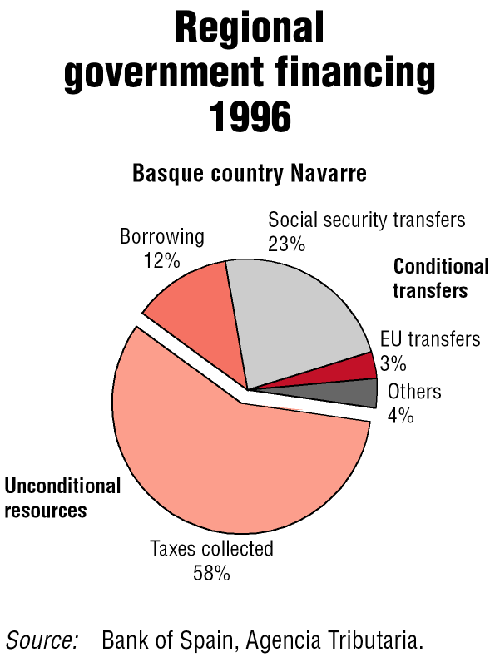|
|
|
|

Economy
Decentralisation in Navarre and the Basque Country
by Isabelle Joumard, Economics Department

Very soon after Spain’s return to democracy, the Constitution of 1978 instituted regional governments. In twenty years, these governments have taken on responsibility for major spending programmes in such areas as primary education, healthcare, public investment and labour market policies. On the revenue side, it was not until 1997 that the regional governments were given some leeway in setting rates and bases, for personal income tax in particular.
Two regions — the Basque Country and Navarre — are exceptions to this model. They receive no transfers from the State to cover their spending. On the contrary, they themselves pay the central authorities a contribution — the so-called cupo — for common expenditure, primarily on defence, foreign affairs and the development of infrastructure, such as airports. In return, the regional governments set their own tax rules (except VAT). They can lower or raise the tax burden to suit the demands of the local population. The trouble is they are also compelled to make cuts in public spending if local tax revenue diminishes. Some observers argue that these regions bear an additional risk, insofar as the amount of the cupo depends on spending decisions taken unilaterally by the State, whereas under most existing models of budgetary federalism it is the State that assumes most of the risks.
The model may work for the Basque Country and Navarre regions. But despite its attraction in enhancing the ability to respond to the preferences of local populations, extending it would nevertheless pose a number of problems. Giving each region broad powers to alter the base and the rates of their taxes would increase the complexity of the tax system. And it would pit the regions into competition with each other. While this would clearly have some beneficial aspects, such as encouraging local authorities to make their public services more efficient, it could also become harmful. It could lead to a “rush to the bottom”, whereby each region scrambles to lower its tax burden faster than the others to attract taxpayers. The model would also reduce the redistribution of resources from rich regions to poor ones to a pittance. How ironic it would be if a country that enjoyed substantial structural transfers from the EU did not in turn redistribute its own resources. END